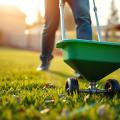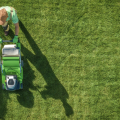Turfgrass and Lawn Management
Turfgrass has been a mainstay of the U.S. urban environment since the mid-20th century, during which large tracts of land were developed to accommodate growing urban populations. Today, turfgrass comprises more than 60,000 square miles of the contiguous United States.
Mississippi has over 2.5 million acres of maintained turf. The largest single component is over 2 million acres of roadside right-of-way.
The second largest component, and the one requiring a majority of inputs, is that of home lawns. Almost 300,000 acres of turfgrass surround Mississippi’s 750,000 homes and residences.
There are over 150 golf courses, over 2,000 athletic fields, and numerous acres of turf surrounding schools, places of worship, and commercial sites.
Benefits of turf are well documented and include: recreational health, erosion control, increased water infiltration, reduced nutrient leaching, aesthetics, carbon sequestration, and mediation of the ‘heat-island’ effect. Yet, the ecological impact of turf is often questioned, due in part to nutrient and water requirements as well as its often unsustainable monoculture cultivation. It is important that homeowners and turfgrass managers follow best management practices that minimize their environmental impact. Proper turf species and variety selection is key.
Many gardeners enjoy maintaining a quality turf. Others despise lawn work and demand a low-maintenance turfgrass. Still others are confused about how to keep a lawn green. You don’t have to be an expert to have a quality lawn; neither do you have to spend all your leisure time working on it. By learning a few basic facts about turfgrass, you can have the best lawn on the block. Also, you can choose a turfgrass to suit the time and money you have for maintenance.
See MSU Extension Publication 1322 Establish and Manage Your Home Lawn to find information about diseases, fertilizing, insect control, planting, selection of grasses, weed control, and other related turf and lawn management materials.
For up to date research results and timely communication about upcoming events, visit our blog site.
The MSU turf team supports numerous statewide stakeholders, including: golf-course superintendents, sports turf managers, sod producers, landscape managers, and homeowners.
Frequently Asked Questions
- Which grass should I plant?
- What is that plastic looking stuff on my greens?
- How do I control weeds in the lawn?
- How often should I mow?
- Why won't grass grow on the crown of my football field?
- Is there money to be made in growing sod?
- What does "aerate" mean?
- What does topdress mean and why is it done?
- When should turfgrass be watered?
- Should I remove clippings?
- When should I dethatch my grass?
- Why is my grass thinning out?
- How do I control weeds?
Website Resources
Publications
News
As summer comes to an end, the time for fall lawn care approaches. Warm-season grass growth is beginning to slow down while temperatures become slightly cooler.
rofessionals involved in the turfgrass industry can register now for a September field day that will showcase Mississippi State University turfgrass research and Extension expertise. The 2024 Turfgrass Research Field Day will be Sept. 19 from 8 a.m. to 3:15 p.m. at the R.R. Foil Plant Science Research Facility in Starkville.
It’s spring, meaning things are starting to grow! The “spring transition,” when grasses go from dormant to active, is in full swing this month.







